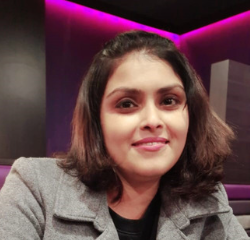
Ms Sandya Nandakumar, Chief Echocardiographer, King's College Hospital NHS Foundation Trust, shares her pathway to TTE accreditation and what it means to her as an echocardiographer.
Being accredited in adult transthoracic echocardiography gives sonographers the capacity to embark on advanced versions of imaging in the field of cardiac ultrasound, cardiovascular research and other physiologist lead services.
Adult TTE accreditation covers a very vast syllabus that include various complex pathologies and haemodynamic. It equips an echocardiographer with a strong theoretical base in both pathologies, haemodynamics and ultrasound physics. The process of accreditation enriches experience through hands on training. The accreditation mandates meticulous understanding and assimilation of the text books, updating knowledge through research papers and updated standard sets.
I came to the UK in September 2018 after completing my Masters degree in Echocardiography and having worked for three years as a senior echocardiographer at a quaternary care centre. After an initial adjustment period - a new country is a big move! - I started to prepare for my theory exam in December 2018.
I was very lucky to work with mentors and seniors colleagues who guided me and made themselves available for every academic clarification that I needed. Periodic departmental discussion were organised regarding the BSE protocols, and inhouse theory classes were taken on ultrasound physics, pathologies and haemodynamics. Mock tests were conducted to train us on question patterns and to give us experience of answering the questions in the allotted time.
One of the most challenging aspects of theory is to acquire a thorough knowledge in ultrasound physics. It is essential to thoroughly internalise the formulas, knobology and image optimisation techniques and their applications in day to day practice, the bottomline being that meticulous reading, focus and dedication is necessary to accomplishaccreditation.
With the theory behind me, I began to collect cases for my logbook. I had to perform various complex pathologies with quantitative assessments which strictly adhered to BSEprotocols to satisfy log book criteria. I had guidance and unstinted support from my mentor and imaging consultant to articulate my reports in accordance with the BSE standards and to give me a second opinion on my assessment of various pathologies. We had departmental meetings on BSE protocols, image optimisation Doppler techniques and also quantification of valvular lesions.
Without such comprehensive guidance and support from this efficient team, I would have stumbled in my road to a successful accreditation. A lesson that I learnt the hard way is that it is essential to upload the cases in the logbook portal on daily or at most a weekly basis rather than allowing them to accumulate. Candidates should ensure each category of pathologies and normal should not exceed the allotted number of reports as it could pose issues when completing the logbook. With a thorough revision, I ensured that I had fully anonymised all patient information.
By the time you start to record your cases for the video portion of the exam, you should have attained a high level of competence to assess and quantify every kind of pathology. It is essential to go through the recording with your mentors and imaging consultants to check for errors and to make the necessary corrections.
BSE TTE accreditation involves an enormous amount of hard work and dedication. When you receive the accreditation certificate with your name on it, it becomes a moment of joy and pride well worth the sacrifice and the sweat.
I am a successfully accredited echocardiographer for which I am grateful to all my teachers, mentors and consultants who have guided me and motivated me right from my graduation to my accreditation from BSE.
I also express my sincere thanks to the BSE team who were always reachable at every step in my path of BSE TTE accreditation.